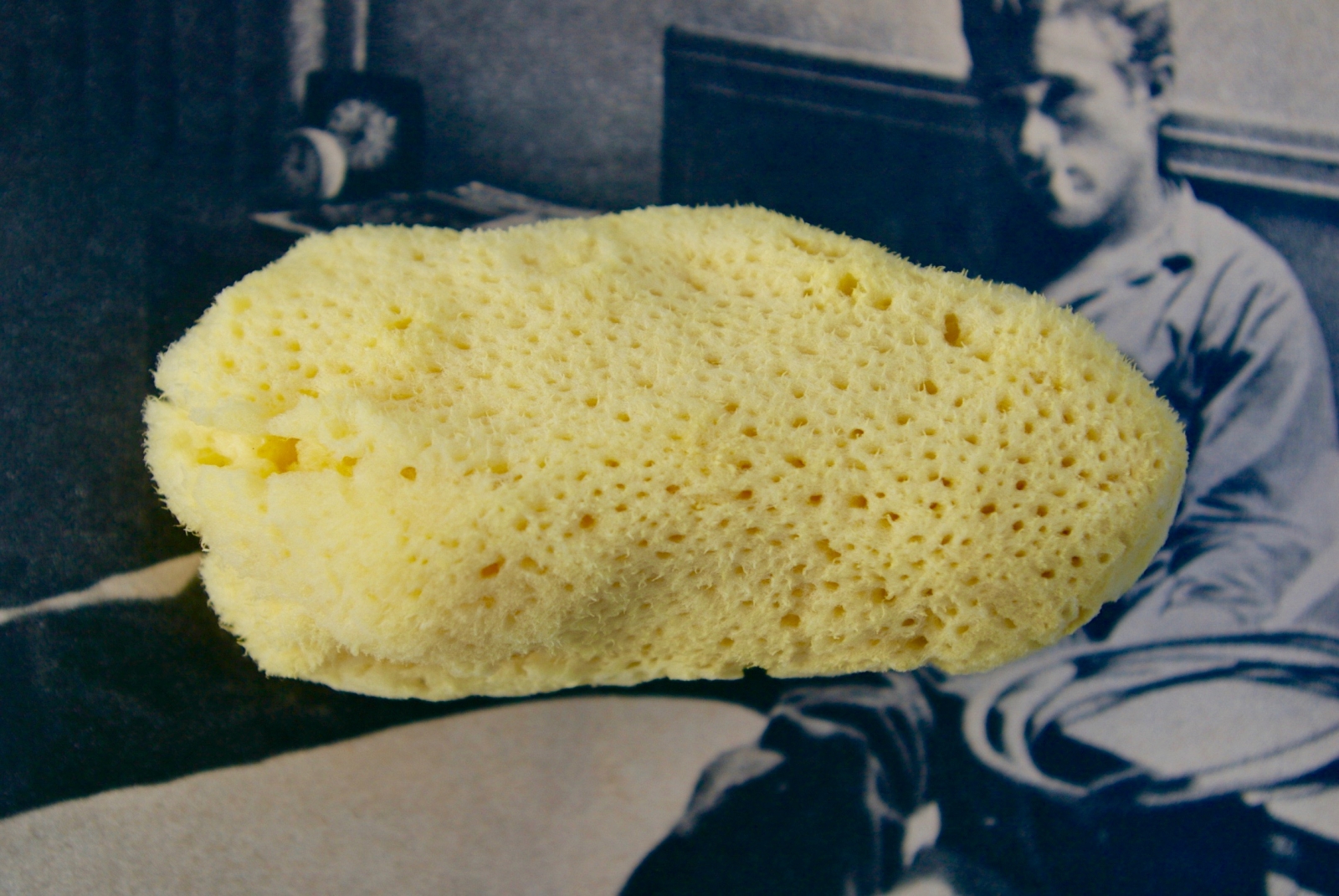Hoo Hoo Rags is no longer sewing. Sea-sponges are still available.
Curious about Nature's tampon??
Click on this photo to view a video I did with lots of sea sponge info. 
If cared for and used properly, natural sea sponges are a safe and fantastic alternative to chemical ridden traditional tampons that have been linked to being causes of things like cervical cancer. Natural sea sponges offer women internal protection for day-to-day activities, the gym, swimming or whatever! (They can even be worn during sex and teamed up with a spermicide, as an alternate form of contraception...be warned though, that pregnancy is NOT completely avoidable with this method.)
The natural sea sponges I offer are fina silk, a fine grained soft sponge sourced directly from Greece. While harvesting, divers carefully remove only the outermost portion of the sponge (similar to pruning trees) to help them regenerate. Their natural reproductive cycles ensure that they often grow bigger and healthier had they not been trimmed. Studies have shown that areas in which sea sponges are harvested actually incur an increase in the sponge population.
Natural sea sponges have not been processed with harmful chemicals and without all the extra packaging like with traditional tampons, these are friendly on our environment. They are fully biodegradable and when they have finally lost their effectiveness you can compost them!
To use your Natural Sea Sponge, simply wet, squeeze, squish small and insert. Once inside, the sponge will expand and mold to your shape. You should not feel it once it is inserted. You can trim them down little by little, but not too much as you don't want to compromise the seal it creates inside. Sea sponges expand 15% when wet. As a rule, attend to your sponge every 3-4 hours or if you "leak" or have fresh blood on the toilet paper when wiping. If there is resistance when trying to remove it...its probably not "full" or ready to come out. I always wear a back-up cloth pad for piece of mind and you can wear your sponge overnight too.
To remove the sponge, it is helpful to bear down with your pelvic floor muscles, then reach in with your fingers, grab hold and gently pull it out. Rinse the sponge under water and reinsert. If out and about, use a water-bottle to rinse into the toilet or squeeze out the blood and place into a mini wet-bag. Attend to the used sponge as soon as possible. Sea sponges are actually filled with natural enzymes that inhibit the growth of mold, mildew and bacteria, making them toxin-free and hypo-allergenic.
There are several ways to disinfect your sponges. Disinfect your sponges before first use, each day used during your cycle, if an unpleasant odor develops and before storing back away after use. Do not use harsh chemicals to clean your sponges. Simply soak for 20-30 minutes in one of the following solutions:
~ 1 cup of warm water mixed with 1 tablespoon of hydrogen peroxide (helps eliminate discoloration)
~ 1 cup of warm water mixed with 1 tablespoon of vinegar (apple cider or white).
~ 1 cup of warm water mixed with 1 tablespoon of baking soda (helps restore volume & density)
~ 1 cup of warm water with 1 teaspoon of colloidal silver. There is no pathogenic organism known that is not killed by colloidal silver in 6 minutes or less.
~ Soak in a cup of warm water and a couple drops of lavender or tea tree oil to eliminate unwanted odors if they occur.
You will know its time to retire your sponges when obvious deterioration has occurred, if they have become less absorbent and/or are not rebounding after each cycle like they did in the beginning. You can expect to get 3-12 months of use depending on your body and how they are cared for.
**DO NOT boil your sponges, this will rapidly shorten their lives and harden them.
The difference between "bleached" and "unbleached" sponges is mostly just the color. Some people are unnerved by the natural brown color of sea sponges, therefore prefer the yellow color. The bleaching process is via hydrogen peroxide and some will say unbleached sponges may have a slightly longer life and are a little less fragile. The brown sponges are often a little more firm, but still very comfortable to use...I have used both and found both to offer substantial protection and life.
Choosing the appropriate sized sponge will depend a lot on your personal period. For example, heavy periods or women with high cervixes will require larger sized sponges and lighter periods or women with low cervixes will require smaller sized sponges. The more in-tune you are with your cycle and body, the better you will be at choosing the sponge that best suits you.
Brown Sea Sponge Pricing (per sponge):
SMALL 1.5"-2" - $4.15
MEDIUM 2-2.5" - $6.16
LARGE 2.5"-3 - $8.30
EXTRA LARGE 3"-3.5" - $11.94
Note: The length is a guide, the width of the sponge will also play a factor in the absobency category each individual sponge will end up in. No two sponges will ever be the same color, texture, firmness, shape etc, remember, these are hand picked from the sea, not made by man.
Heart Shaped Cup/Sponge-Spots are $3 and can be topped with OBV for $0.50 extra. These are a great thing to have around for placing your sponge on when out and about, at home in the bathroom while doing business and/or clean place to set your wet sponge on to dry after sanitizing it.
But...
“But won’t it get lost or stuck up there?”
Where is it going to hide? It can’t get stuck either. If you are really worried you can tie a bit of non-minty dental floss around it to help you remove it. Also, as the sponge "fills" it gets heavier and starts moving its way down...its not going to falll out!...you will know its time to attend to it when you have a "leak" or there is fresh blood on the toilet paper when you wipe.
“But, I have an IUD.”
You can still use natural sea sponges even if you have an IUD, you just need to take extra care in insertion and removal.
“But, I read on the internet that sponges were banned for menstrual use?”
Lots of articles raise concerns about use of menstrual sponge tampons because of contaminants and its true that sponges can contain small amounts of sand/seaweed/shell (Which can easily be removed, and once gone, they're gone for good!). Many women have used sponges their whole menstrual life, way before traditional tampons became available, without any adverse affects. Whereas, we've all read about or know women who have had ‘lost’ tampons or have had TSS, so I wouldn’t worry too much if I were you.
“But it’s huge, I’ll never fit that in!”
It looks WAY scarier than it is, I promise! When wet these little blood pillows squish nice and small! But if you try it and still feel uncomfortable, it may need to be inserted a little further or you can just trim a few millimeters away from the outside edge until it feels better. If you cut it too small it won’t create a good seal, so just a little at a time.
“Do they come in different absorbencies?”
YES! The size of the sea sponge will pretty much determine the absorbency. Cervix height also plays a big part in the size of the sponge you will need...the higher cervixes may require the larger sponges to be most effective and easiest to remove. You can put them in sideways or lengthways depending on the shape of your insides, they should not be uncomfortable when they are in. You can even wear more than one at a time if you need to.
“But I have really heavy periods!”
These sponges absorb a surprisingly large amount of fluid! Wear one larger sponge or two sponges at once, one higher and one lower.
“But I have really light periods!”
Sponges are easy to remove when they are full as they get heavier and work their way down. With a very light flow this won’t happen as much. If your flow is heavy enough to need a low absorbency tampon then a small sea sponge should be fine for you.
“How long have people used sponges as tampon alternatives?”
According to the Museum of Menstruation and Women’s Health, “Women have probably used sponges to absorb menstrual discharge for thousands of years, but they have also used them as contraceptives and for putting medication into the vagina. Sometimes it’s hard to say which sponge was used for what – but maybe women sometimes used them for all three purposes.”
"But is there still a risk of TSS?"
There is always a risk of Toxic Shock Syndrome when using menstrual items being inserted into the vagina, but the risk is considerably less than with disposable tampons.
I just want to add the information about TSS for anyone who does not know what it is or what to look for. Always take precautions with ANYTHING being inserted into the vagina, clean hands and tenderness is a must!
“Toxic shock syndrome (TSS) is a rare, acute and serious illness, affecting around 40 people in the UK each year. The link between TSS and tampon use is unclear. Research suggests that for cases which occur in women using tampons, tampon absorbency is a factor. For this reason it is important that women:
Always use a tampon with the lowest absorbency suitable for period flow.
Use a sanitary towel or panty liner from time to time during their period.
Wash their hands before and after inserting a tampon.
Change tampons regularly, as often as directed on the pack.
Never insert more than one tampon at a time.
When using at night, insert a fresh tampon before going to bed and remove it on waking.
Remove a tampon at the end of a period.
Tampon-associated TSS rates are low – there are around 4-5 identified cases a year. It is very important to detect shock early, and get emergency treatment as quickly as possible. If you have any of the following symptoms please remove your sea sponge immediatly. If TSS is diagnosed, this action may help to prevent symptoms from worsening...vomiting, diarrhoea, a sunburn-like rash, muscle aches, sudden high temperature (fever), drowsiness or confusion, fainting or dizziness, and collapse.
